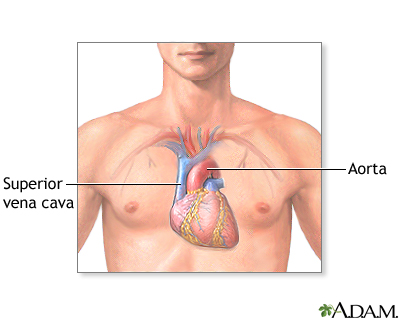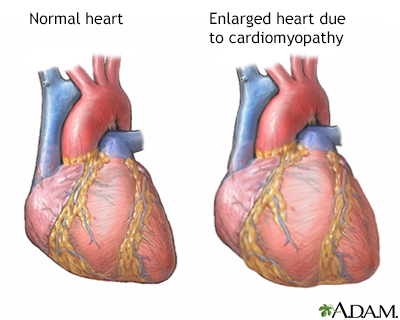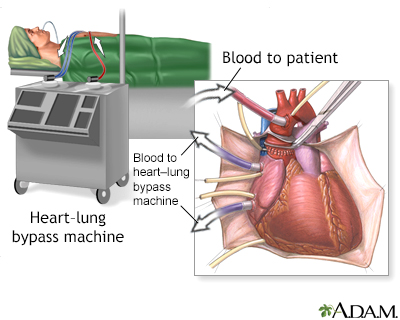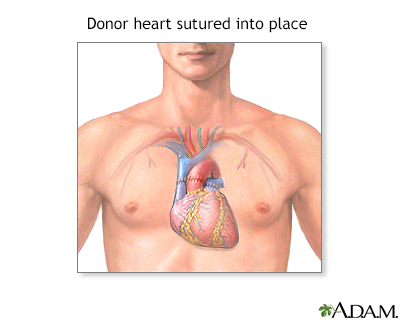Heart transplant
Cardiac transplant; Transplant - heart; Transplantation - heartA heart transplant is surgery to remove a damaged or diseased heart and replace it with a healthy donor heart.
Description
Finding a donor heart can be difficult. The heart must be donated by someone who is brain-dead but is still on life support. The donor heart must be in normal condition without disease and must be matched as closely as possible to your blood and tissue type to reduce the chance that your body will reject it.
For this surgery, you are put into a deep sleep with general anesthesia, and a cut is made through the breastbone.
General anesthesia
General anesthesia is treatment with certain medicines that puts you into a deep sleep-like state so you do not feel pain during surgery. After you ...
- Your blood flows through a heart-lung bypass machine while the surgeon works on your heart. This machine does the work of your heart and lungs while they are stopped, and supplies your body with blood and oxygen.
- Your diseased heart is removed and the donor heart is stitched in place. The heart-lung machine is then disconnected. Blood flows through the transplanted heart, which takes over supplying your body with blood and oxygen.
- Tubes are inserted to drain air, fluid, and blood out of the chest for several days, and to allow the lungs to fully re-expand.
Why the Procedure Is Performed
A heart transplant may be done to treat:
- Severe heart damage after a heart attack
- Severe heart failure, when medicines, other treatments, and surgery no longer help
Heart failure
Heart failure is a condition in which the heart is no longer able to pump oxygen-rich blood to the rest of the body efficiently. This causes symptom...
 ImageRead Article Now Book Mark Article
ImageRead Article Now Book Mark Article - Severe heart defects that were present at birth and can't be fixed with surgery
- Life-threatening abnormal heartbeats or rhythms that do not respond to other treatments
Heart transplant surgery may not be used in people who:
- Are malnourished
Malnourished
Malnutrition is the condition that occurs when your body does not get enough nutrients.
 ImageRead Article Now Book Mark Article
ImageRead Article Now Book Mark Article - Are older than age 65 to 70
- Have had a severe stroke or dementia
Stroke
A stroke occurs when blood flow to a part of the brain stops. A stroke is sometimes called a "brain attack. " If blood flow is cut off for longer th...
 ImageRead Article Now Book Mark Article
ImageRead Article Now Book Mark ArticleDementia
Dementia is a loss of brain function that occurs with certain diseases. It affects one or more brain functions such as memory, thinking, language, j...
 ImageRead Article Now Book Mark Article
ImageRead Article Now Book Mark Article - Have had cancer within the past 2 years
- Have HIV infection
- Have infections, such as hepatitis, that are active
Hepatitis
Hepatitis is swelling and inflammation of the liver.
 ImageRead Article Now Book Mark Article
ImageRead Article Now Book Mark Article - Have insulin-dependent diabetes and other organs, such as the kidneys, that aren't working correctly
Insulin-dependent diabetes
Type 1 diabetes is a lifelong (chronic) disease in which there is a high level of sugar (glucose) in the blood.
 ImageRead Article Now Book Mark Article
ImageRead Article Now Book Mark Article - Have kidney, lung, nerve, or liver disease
Liver disease
The term "liver disease" applies to many conditions that stop the liver from working or prevent it from functioning well. Abdominal pain or swelling...
 ImageRead Article Now Book Mark Article
ImageRead Article Now Book Mark Article - Have no family support and do not follow their treatment
- Have other diseases that affect the blood vessels of the neck and leg
- Have pulmonary hypertension (thickening of blood vessels in the lung)
Pulmonary hypertension
Pulmonary hypertension is high blood pressure in the pulmonary arteries of the lungs. It makes the right side of the heart work harder than normal....
 ImageRead Article Now Book Mark Article
ImageRead Article Now Book Mark Article - Smoke or use excessive alcohol or drugs, or have other lifestyle habits that may damage the new heart
- Are not reliable enough to take their medicines, or if the person is not able to keep up with the many hospital and medical office visits and tests
Risks
Risks from any anesthesia are:
- Reactions to medicines
- Problems breathing
Risks from any surgery are:
- Bleeding
- Infection
Risks of transplant include:
- Blood clots (deep venous thrombosis)
Deep venous thrombosis
Deep vein thrombosis (DVT) is a condition that occurs when a blood clot forms in a vein deep inside a part of the body. DVT mainly affects the large...
 ImageRead Article Now Book Mark Article
ImageRead Article Now Book Mark Article - Damage to the kidneys, liver, or other organs from anti-rejection medicines
- Development of cancer from the medicines used to prevent rejection
- Heart attack or stroke
- Heart rhythm problems
- High cholesterol levels, diabetes, and bone thinning from the use of rejection medicines
- Increased risk for infections due to anti-rejection medicines
- Lung and kidney failure
- Rejection of the heart
- Severe coronary artery disease
Coronary artery disease
Coronary heart disease is a narrowing of the blood vessels that supply blood and oxygen to the heart. Coronary heart disease (CHD) is also called co...
 ImageRead Article Now Book Mark Article
ImageRead Article Now Book Mark Article - Wound infections
- The new heart may not work at all
Before the Procedure
Once you are referred to a transplant center, you will be evaluated by the transplant team. They will want to make sure that you are a good candidate for a transplant. You will visit many times over several weeks or even months. You will need to have blood drawn and x-rays taken. The following may also be done:
- Blood or skin tests to check for infections
- Tests of your kidney and liver
- Tests to evaluate your heart, such as ECG, echocardiogram, and cardiac catheterization
ECG
An electrocardiogram (ECG) is a test that records the electrical activity of the heart.
 ImageRead Article Now Book Mark Article
ImageRead Article Now Book Mark ArticleEchocardiogram
An echocardiogram is a test that uses sound waves to create pictures of the heart. The picture and information it produces is more detailed than a s...
 ImageRead Article Now Book Mark Article
ImageRead Article Now Book Mark ArticleCardiac catheterization
Cardiac catheterization involves passing a thin flexible tube (catheter) into the right or left side of the heart. The catheter is most often insert...
 ImageRead Article Now Book Mark Article
ImageRead Article Now Book Mark Article - Tests to look for cancer
-
Tissue and blood typing, to help make sure your body will not reject the donated heart
Tissue and blood typing
A histocompatibility antigen blood test looks at proteins called human leukocyte antigens (HLAs). These are found on the surface of almost all cells...
 ImageRead Article Now Book Mark Article
ImageRead Article Now Book Mark Article - Ultrasound of your neck and legs
You will want to look at one or more transplant centers to see which would be best for you:
- Ask them how many transplants they perform every year and what their survival rates are. Compare these numbers with the numbers from other centers. These are all available on the internet at unos.org.
- Ask what support groups they have available and how much help they offer with travel and housing.
- Ask about the costs of medicines you will need to take afterwards and if there is any financial help in getting the medicines.
If the transplant team believes you are a good candidate, you will be put on a regional waiting list for a heart:
- Your place on the list is based on several factors. Key factors include the type and severity of your heart disease, and how sick you are at the time you are listed.
- The amount of time you spend on a waiting list is usually NOT a factor for how soon you get a heart, except in the case of children.
Most, but not all, people who are waiting for a heart transplant are very ill and need to be in the hospital. Many will need some sort of device to help their heart pump enough blood to the body. Most often, this is a ventricular assist device (VAD).
Ventricular assist device
Ventricular assist devices (VADs) help your heart pump blood from one of the main pumping chambers to the rest of your body or to the other side of t...

After the Procedure
You should expect to stay in the hospital for 7 to 21 days after a heart transplant. The first 24 to 48 hours will likely be in the intensive care unit (ICU). During the first few days after a transplant, you will need close follow-up to make sure that you do not get an infection and your heart is working well.
The recovery period is about 3 months and often, your transplant team will ask you to stay fairly close to the hospital during that time period. You will need to have regular check-ups with blood tests, x-rays, and echocardiograms for many years.
Fighting rejection is an ongoing process. The body's immune system considers the transplanted organ a foreign body and fights it. For this reason, organ transplant patients must take medicines that suppress the body's immune response. To prevent rejection, it is very important to take these medicines and carefully follow your self-care instructions.
Immune response
The immune response is how your body recognizes and defends itself against bacteria, viruses, and substances that appear foreign and harmful....

Biopsies of the heart muscle are often done every month during the first 6 to 12 months after transplant, and then less often after that. This helps determine if your body is rejecting the new heart, even before you have symptoms.
Biopsies
A biopsy is the removal of a small piece of tissue for lab examination.

You must take medicines that prevent transplant rejection for the rest of your life. You will need to understand how to take these medicines, and know their side effects.
You can go back to your normal activities 3 months after the transplant as soon as you feel well enough, and after talking with your health care provider. Consult your provider if you plan to engage in vigorous physical activity.
If you develop coronary disease after a transplant, you may have cardiac catheterization every year.
Cardiac catheterization
Cardiac catheterization involves passing a thin flexible tube (catheter) into the right or left side of the heart. The catheter is most often insert...

Outlook (Prognosis)
Heart transplant prolongs the life of people who would otherwise die. About 90% of heart transplant patients are alive 1 year after the operation. At 3 years, more than 85% of patients will still be alive after a heart transplant.
The main problem, as with other transplants, is rejection. If rejection can be controlled, survival increases to over 10 years.
References
Heidenreich PA, Bozkurt B, Aguilar D, et al. 2022 AHA/ACC/HFSA Guideline for the Management of Heart Failure: A Report of the American College of Cardiology/American Heart Association Joint Committee on Clinical Practice Guidelines. Circulation. 2022;145(18):e895–e1032. PMID: 35363499 pubmed.ncbi.nlm.nih.gov/35363499/.
Kliegman RM, St. Geme JW, Blum NJ, et al. Pediatric heart and heart-lung transplantation. In: Kliegman RM, St. Geme JW, Blum NJ, et al, eds. Nelson Textbook of Pediatrics. 22nd ed. Philaelphia, PA: Elsevier; 2025:chap 492.
McMurray JJV, Pfeffer MA. Heart failure: Treatment and prognosis. In: Goldman L, Cooney KA, eds. Goldman-Cecil Medicine. 27th ed. Philadelphia, PA: Elsevier; 2024:chap 46.
Shudo Y, Hiesinger W, Woo YJ. Heart transplantation. In: Sellke FW, del Nido PJ, Swanson SJ, eds. Sabiston and Spencer Surgery of the Chest. 10th ed. Philadelphia, PA: Elsevier; 2024:chap 102.
Starling RC. Cardiac transplantation. In: Libby P, Bonow RO, Mann DL, Tomaselli GF, Bhatt DL, Solomon SD, eds. Braunwald's Heart Disease: A Textbook of Cardiovascular Medicine. 12th ed. Philadelphia, PA: Elsevier; 2022:chap 60.
-
Heart - section through the middle - illustration
The interior of the heart is composed of valves, chambers, and associated vessels.
Heart - section through the middle
illustration
-
Heart - front view - illustration
The external structures of the heart include the ventricles, atria, arteries and veins. Arteries carry blood away from the heart while veins carry blood into the heart. The vessels colored blue indicate the transport of blood with relatively low content of oxygen and high content of carbon dioxide. The vessels colored red indicate the transport of blood with relatively high content of oxygen and low content of carbon dioxide.
Heart - front view
illustration
-
Normal anatomy of the heart - illustration
The heart is made up of the two atria which receive blood and two ventricles which are the actual pumps of the heart. The left ventricle pumps blood into the aorta sending oxygenated blood to the rest of the body.
Normal anatomy of the heart
illustration
-
Heart transplant - series
Presentation
-
Heart - section through the middle - illustration
The interior of the heart is composed of valves, chambers, and associated vessels.
Heart - section through the middle
illustration
-
Heart - front view - illustration
The external structures of the heart include the ventricles, atria, arteries and veins. Arteries carry blood away from the heart while veins carry blood into the heart. The vessels colored blue indicate the transport of blood with relatively low content of oxygen and high content of carbon dioxide. The vessels colored red indicate the transport of blood with relatively high content of oxygen and low content of carbon dioxide.
Heart - front view
illustration
-
Normal anatomy of the heart - illustration
The heart is made up of the two atria which receive blood and two ventricles which are the actual pumps of the heart. The left ventricle pumps blood into the aorta sending oxygenated blood to the rest of the body.
Normal anatomy of the heart
illustration
-
Heart transplant - series
Presentation
Review Date: 5/5/2025
Reviewed By: Michael A. Chen, MD, PhD, Associate Professor of Medicine, Division of Cardiology, Harborview Medical Center, University of Washington Medical School, Seattle, WA. Also reviewed by David C. Dugdale, MD, Medical Director, Brenda Conaway, Editorial Director, and the A.D.A.M. Editorial team.









